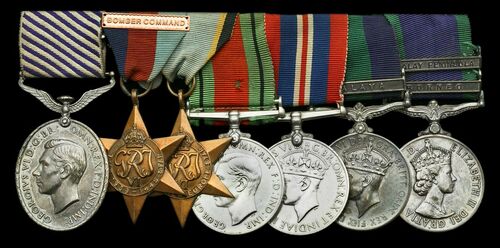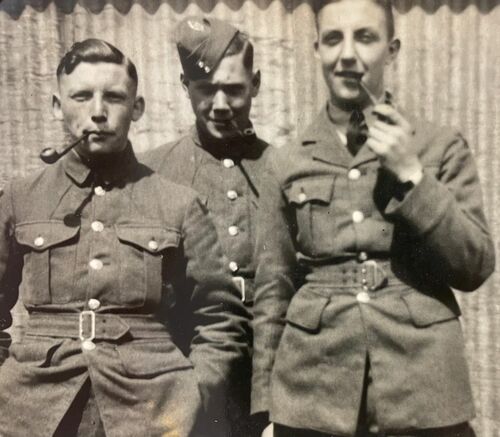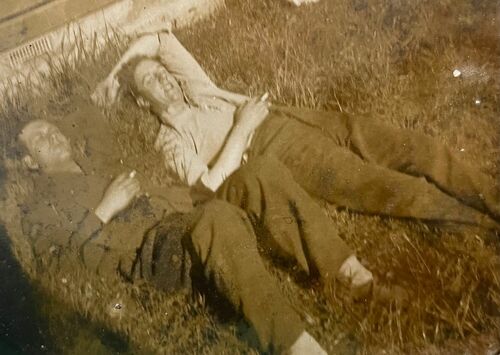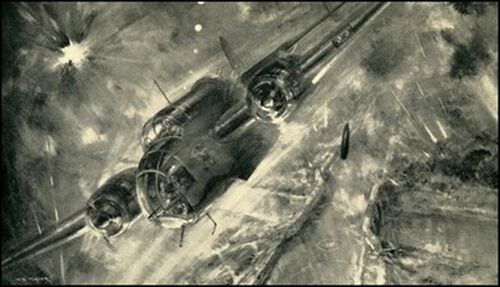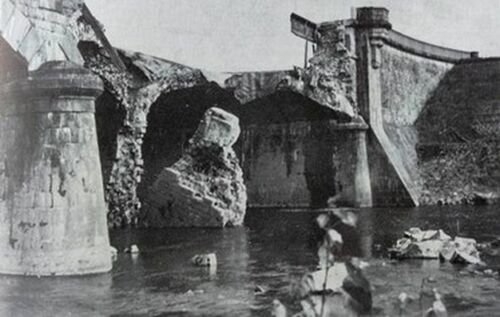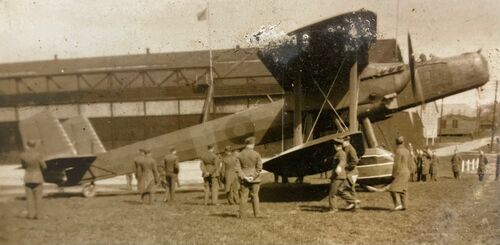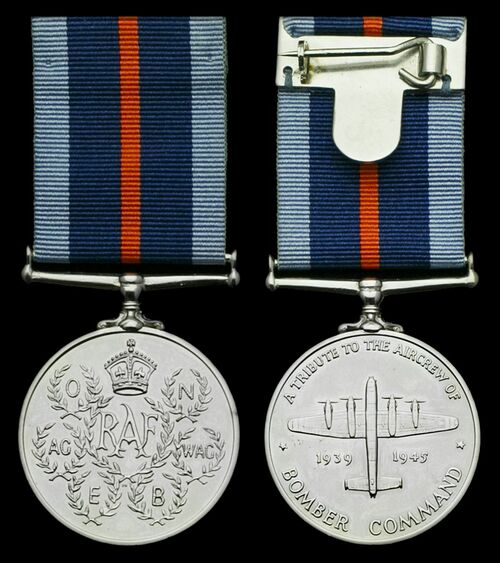Auction: 23003 - Orders, Decorations and Medals
Lot: 320
Sold by Order of a Direct Descendant
'As Learoyd waited calmly he saw the first Hampden begin its run over the canal: Squadron Leader 'Jamie' Pitcairn-Hill, D.F.C., of 83 Squadron in Hampden P4402.
Along each bank of the canal were rows of deadly mobile flak guns, well-sited, and presenting any potential attacker with no choice but to run the narrow gauntlet of anti-aircraft fire during his actual bombing attack. Knowing these odds against survival, Pitcairn-Hill led the way in - threading his way through a curtain of shells and tracer bullets, and in the face of blinding searchlights focussed directly on the approach lane. Levelling out at 100 feet above the silver water canal, he suffered numerous hits but refused to evade the punishment, maintaining a rock-steady bombing run and releasing his bomb canisters with precision, before banking away from the danger zone and limping home to England …'
For Valour - The Air VCs, by Chaz Bowyer, refers.
An outstanding Second World War D.F.M. group of seven awarded to Wing Commander, late Sergeant G. R. Roscoe, Royal Air Force, who somehow survived the famous low-level attack on a viaduct of the Dortmund-Ems canal on the night of 12-13 August 1940, an action in which Squadron Leader R. A. B. 'Babe' Learoyd won a popular award of the V.C.
For his own part, Roscoe served a Wireless Operator and Air Gunner in Squadron Leader 'Jamie' Pitcairn-Hill's crew, their Hampden of No. 83 Squadron, as cited above, being charged with the unenvious task of leading the attack.
On finally getting back to R.A.F. Scampton, ground crew were horrified by the aircraft's state: 'It looked as though someone had taken a giant shotgun to it, such were the number of holes and gashes in the fuselage and wings.'
Roscoe - who suffered head wounds and was admitted to hospital - was no stranger to the perilous nature of air operations, having previously flown around 30 sorties with No. 83 Squadron and, in the opening months of the war, as a member of Guy Gibson's crew
Distinguished Flying Medal, G.VI.R. (545616. Sgt. G. R. Roscoe. R.A.F.); 1939-45 Star, clasp, Bomber Command; Air Crew Europe Star; Defence and War Medals 1939-45; General Service 1918-62, 1 clasp, Malaya (Flt. Lt. G. R. Roscoe. R.A.F.); General Service 1962-2007, 2 clasps, Borneo, Malay Peninsula (Wg. Cdr. G. R. Roscoe. R.A.F.), mounted as worn, very fine (7)
D.F.M. London Gazette 13 September 1940. The original recommendation - signed-off as 'strongly recommended' by Air Vice-Marshal A. T. 'Bomber' Harris, then C.O. of No. 5 Group - states:
'Sergeant Roscoe has carried out a total of 27 operations against the enemy, in the course of which he has completed 183 hours operational flying.
He has at all times displayed the utmost skill, determination and courage in the face of the enemy, both as an Air Gunner and Wireless Operator. His work has been outstanding, and his keenness and enthusiasm have been a source of inspiration to all other Wireless Operators and Air Gunners in his squadron.'
George Raymond Roscoe was born in Manchester on 14 March 1920 and was a pre-war R.A.F. entrant. Qualifying as a Wireless Operator in November 1938, prior to joining No. 83 Squadron at Scampton in the following month, he also qualified as an Air Gunner in May 1939.
The Guy Gibson connection
Having participated in the squadron's first sortie of the war - a reconnaissance flown on 3 September 1939 - Roscoe and his fellow aircrew remained on a non-operational footing until April 1940, a period in which he flew with Guy Gibson's crew on several occasions. It was a frustrating period, the future hero of the Dambusters raid later writing:
'To say that we were all keen would be a masterpiece of understatement … we had waited so long that we were all completely brassed off.'
But the waiting finally came to an end in April 1940, when No. 83 became fully operational, Roscoe by this time having joined Squadron Leader 'Jamie' Pitcairn-Hill's crew. The latter, the son of a vicar, was a well-known R.A.F. Rugby player. They quickly flew a recce to the Skaggerak, in addition to undertaking 'gardening' operations, and they completed nine further sorties in May, ten in June and five in July, the latter including strikes on targets located in Frankfurt, Kiel and Ludwigshaven.
Nor were these outings without incident, a case in point being a 'gardening' trip off Copenhagen, an incident described in some detail by Mark Felton in The Bridge Busters. With their bomb load hung up, and landing gear jammed in a downward direction, owing to a loss of hydraulics, Pitcairn-Hill had to coax the Hampden back to England at a speed of just 120 m.p.h. And it was getting light, too. Then, with the arrival of a prowling Me. 109 on the scene, their fate appeared to be sealed. Yet, in one of those strange quirks of war, the pilot of the 109 mistook their Hampden for a Dornier 17 and flew off.
A few nights later, Pitcairn-Hill and Guy Gibson were allocated to an attack on a pair of railway tunnels near Aachen. Their orders were to 'roll their bombs like billiard balls' into the tunnel entrances. In his run-up to one end of his chosen tunnel, Pitcairn-Hill spotted a train approaching in the distance. So, he flew on ahead to the other end of the lengthy tunnel and rolled two bombs into that entrance. He then returned to the other entrance, awaited the train to enter the tunnel, and rolled two further bombs in, thereby entombing the train. It was, as Mark Felton observes, 'a remarkably uncharitable performance, but effective nonetheless.'
Dortmund-Ems canal, 12-13 August 1940
But it was in August that Roscoe and his crew faced their greatest challenge, having been selected as one of six Hampden crews drawn from the strength of 49 and 83 Squadrons to attack the M.25 viaduct on the Dortmund-Ems canal. Furthermore, 'Jamie' Pitcairn-Hill was given the dubious privilege of leading the attack.
Equipped with special M-bombs, set with a 10-minute time delay, the Hampdens in question had to deliver their attacks at two-minute intervals from a height of 100-150 feet. Moreover, they faced formidable defences, including blinding searchlights and flak guns of the heavy calibre variety.
The subsequent experiences of Roscoe and his crew are vividly described in Mark Felton's The Bridge Busters:
'Pitcairn-Hill's plane was at 3,000 feet, circling gently south of the target while the rest of the attack force started to arrive and join the cab rank of Hampdens that waited patiently to strike. As Bombing Leader, he would be first to attack the aqueduct.
"George, send the following signal," he said over the R/T to his wireless operator, George Roscoe. "Am going to attack. Stand by to come in on your agreed order and times."
"Okay, skipper" came Roscoe's calm reply. Roscoe shuffled awkwardly from his upper gun position to where the radio was bolted to the wall, and pulled off his right glove. He quickly tapped pout a message using the Morse key. Then he waited a minute until all the other aircraft had acknowledged his signal before reporting back to Pitcairn-Hill.
"Right, boys, this is it," Pitcairn-Hill said, "We're going in. All set Harrison?" The navigator, Flying Officer Harrison, replied that he was. "Guns, ready?"
"Yes, skipper," replied Aircraftman Bale, the ventral gunner.
"Cleared for action, skip," Roscoe said, after he had squeezed back into the cramped upper turret position.
"Right," Pitcairn-Hill, his voice a little shaky, replied, "attacking now." It was precisely 11:15 p.m. - 'zero hour' … '
Mark Felton's The Bridge Busters, continues:
'The German gunners could hardly believe what they were seeing. Pitcairn-Hill's lone Hampden dropped lower and lower towards the canal and simultaneously slowed down. The 20mm and 37mm cannon crews depressed their barrels and poured forth a stunning display of rapid fire, and within seconds they had started to find their mark.
Aboard Pitcairn-Hill's aircraft, the two rear gunners were firing pan after pan of machine gun bullets at the flak positions and searchlights as their plane followed the canal, continuing to drop lower and lower until it seemed almost certain that they would crash into the shimmering water's surface.
"Left!" navigator Flying Officer Harrison screamed from his seat in the nose, as he desperately tried to keep his bombsight on the rapidly approaching aqueduct. "Down the middle, skip, steady … steady."
There was a loud thump, followed by another crash and the Hampden veered suddenly to starboard as a couple of 20mm shells exploded near the airframe.
"Left, skipper, left!" Harrison yelled, and above and behind him in the narrow cockpit Pitcairn-Hill cursed and swore with anger and fear as his aircraft was struck again and again by shells and shrapnel. He struggled to keep the Hampden on the track, responding each time to Harrison's agonized instructions with a touch of the stick. He glanced at his altimeter - it read barely 100 feet. Another loud bang and the sound of breaking glass rocked the plane.
"Steady … steady …" came Harrison's voice from the front. "Bomb away," he suddenly cried and the weapon fell from the bay just as another shell crashed into the fuselage.
Pitcairn-Hill didn't hesitate - he slammed the throttles forward on both of his engines and, keeping low, he hammered across the countryside, trying to put as much distance as he could between his damaged plane and those dreadful flak guns.
"Did you see it land?" Pitcairn-Hill shouted into the R/T over the screaming of wind through his shattered cockpit canopy.
"No, skip, too much flak and searchlights," Aircraftman Bale, the ventral gunner, shouted back.
"I think it was spot on," Harrison reported. It was too difficult to tell and they wouldn't be hanging around to find out.
"Is everybody okay," Pitcairn-Hill demanded, as he started to climb up and set course for England.
"George is wounded," Bale reported.
"I'm alright, skip, it's just a flesh wound," Sergeant Roscoe, the wireless operator, shouted back. He'd taken some shrapnel hits to the head and blood was running down one side of his face from ugly gashes in his leather flying helmet.
"Sort him out, will you Bale," Pitcairn-Hill ordered. Bale pulled himself out of his ventral gunner's position and quickly patched Roscoe up as the wireless operator sent a Morse message to Scampton reporting attacking the target.
"What state's the kite, in skip?" Harrison asked.
"She's taken quite a beating," Pitcairn-Hill responded, "but the engines look to be okay. Oil pressure is fine. Hydraulics are all good." They had been very lucky. Flak hits had torn some ugly holes in the fuselage and wings, but the engines miraculously had not been damaged. Some of the control surfaces were damaged, and Pitcairn-Hill's controls were rather heavy and sluggish, but the Hampden resolutely remained airborne. Probably the German gunners had been unused to engaging such a low and slow target, and before they had recovered fully from their shock at the British plane's seemingly suicidal bombing run, Pitcairn-Hill had been through and away on the other side of the M.25. Wind shrieked and howled through dozens of ugly jagged holes blown in the aircraft fuselage or through shattered panes of Perspex and glass … '
At length, Pitcairn-Hill coaxed the seriously damaged Hampden back to R.A.F. Scampton, where he landed without further incident in the early morning hours.
Roscoe had indeed sustained shrapnel wounds to his head and was later admitted to Raunceby Hospital. Then he 'flew only one more operational sortie before being permanently grounded due to an ear problem.'
Pitcairn-Hill, who was awarded an immediate D.S.O. for his gallant leadership in the raid, was less fortunate: he was shot down and killed over the Seine estuary in September 1940.
The equally gallant Roscoe remained employed on ground duties in the R.A.F. until 1969, witnessing active service in Malaya and Borneo. He died at Chichester, West Sussex in January 2002.
Sold with the recipient's original R.A.F. Air Observer's and Air Gunner's Flying Log Book, covering the period January 1939 to January 1942, small photograph album with mainly pre-War images and his Bomber Command Commemorative Medal besides a copy of Mark Felton's excellent history, The Bridge Busters.
Subject to 20% VAT on Buyer’s Premium. For more information please view Terms and Conditions for Buyers.
Sold for
£4,200
Starting price
£2700

